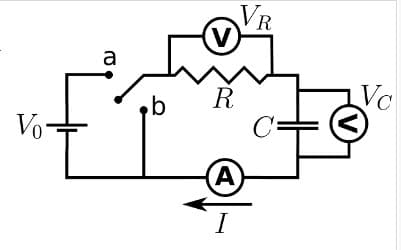Charging a Capacitor: An RC circuit includes a basic switch. In position "a", the battery, resistor and capacitor are connected in series, and the capacitor charges. In position "b", the battery is replaced with a short, and the capacitor will discharge. Two voltmeters and an ammeter have been added to the circuit. A) The switch is moved to position "a", and the capacitor begins charging. At any given instant in the process, let "I" represent the current flowing through the ammeter, and let "q" represent the charge that has accumulated on the positively charged capacitor plate. Enter an expression for Kirchhoff's Loop Rule where the sum of the voltage changes totals zero. B)Since the current is the rate of charge flow, substitute "dq/dt" for "I" in your expression from the previous step. With a little algebra, rearrange your expression so that all references to time appear on the left-hand side and all references to charge appear on the right-hand side. Input an expression for the right-hand side of your equation that is equal to "-dt/τ" where "τ=RC". (Henceforth we use a shorthand notation for the "time constant" and substitute "τ" for the product "RC".) C) Assume that the capacitor is initially uncharged, and then the switch is closed to position "a" at time "t0". Which of these equations is a correctly written integral expression including the correct limits? (Recall the shorthand notation for the time constant introduced in the previous step, "τ=RC".) D) Which choice shows the correct evaluation of the integrals? E) Enter an expression for the charge as a function of time. F)What is the maximum value of the current after the switch is closed? G) Enter an expression for the current as a function of time. Your answer must explicitly reference the maximum current, Imax, that was determined in the previous step. H) Enter an expression for the voltage measured across the resistor, VR, as a function of time. I) Enter an expression for the voltage measured across the capacitor, VC, as a function of time. J) Add an expression for the sum of the voltages across the resistor and the capacitor as a function of time, VR + VC
Charging a Capacitor: An RC circuit includes a basic switch. In position "a", the battery, resistor and capacitor are connected in series, and the capacitor charges. In position "b", the battery is replaced with a short, and the capacitor will discharge. Two voltmeters and an ammeter have been added to the circuit.
A) The switch is moved to position "a", and the capacitor begins charging. At any given instant in the process, let "I" represent the current flowing through the ammeter, and let "q" represent the charge that has accumulated on the positively charged capacitor plate. Enter an expression for Kirchhoff's Loop Rule where the sum of the voltage changes totals zero.
B)Since the current is the rate of charge flow, substitute "dq/dt" for "I" in your expression from the previous step. With a little algebra, rearrange your expression so that all references to time appear on the left-hand side and all references to charge appear on the right-hand side. Input an expression for the right-hand side of your equation that is equal to "-dt/τ" where "τ=RC". (Henceforth we use a shorthand notation for the "time constant" and substitute "τ" for the product "RC".)
C) Assume that the capacitor is initially uncharged, and then the switch is closed to position "a" at time "t0". Which of these equations is a correctly written integral expression including the correct limits? (Recall the shorthand notation for the time constant introduced in the previous step, "τ=RC".)
D) Which choice shows the correct evaluation of the integrals?
E) Enter an expression for the charge as a function of time.
F)What is the maximum value of the current after the switch is closed?
G) Enter an expression for the current as a function of time. Your answer must explicitly reference the maximum current, Imax, that was determined in the previous step.
H) Enter an expression for the voltage measured across the resistor, VR, as a function of time.
I) Enter an expression for the voltage measured across the capacitor, VC, as a function of time.
J) Add an expression for the sum of the voltages across the resistor and the capacitor as a function of time, VR + VC.

Trending now
This is a popular solution!
Step by step
Solved in 4 steps with 15 images









